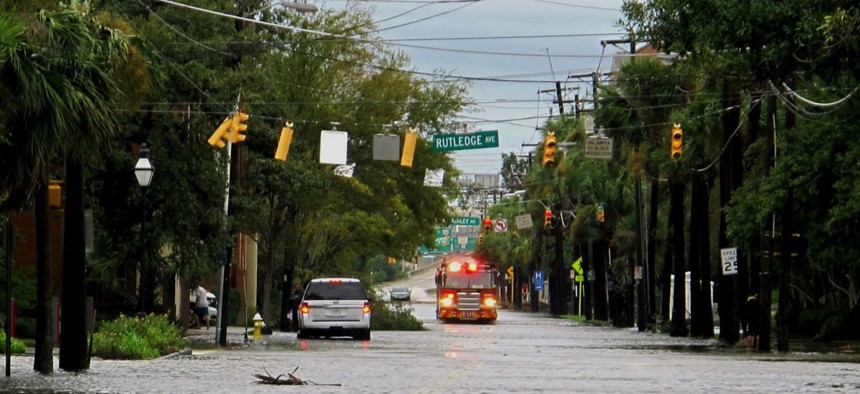The Recovery Begins in South Carolina. Again.

A firetruck drives through a flooded street in the hospital district of Charleston, S.C. on Saturday Bruce Smith / AP Photo
The Charleston area is no stranger to flooding.
Cleanup has begun in Charleston, South Carolina following Hurricane Matthew’s weekend trek up the southeastern U.S. coast. The storm dumped record amounts of rain on the region and brought storm surge into low-lying communities.
As rivers continue to run high in many areas, especially in eastern North Carolina, down the coast in South Carolina’s Lowcountry, communities, including Charleston, are in the early stages of recovery. Again.
As The Post and Courier reports, with Matthew, some parts of the Charleston area are experiencing their third major flood in three years or second major flood in one year. “I don’t ever want to be rescued again,” Donna Perry, a resident in the Bridge Pointe area, told the newspaper.
Last October, South Carolina’s Lowcountry and Midlands were inundated by tropical precipitation associated with Hurricane Joaquin. The hurricane never made landfall, but 19 deaths were attributed to flooding and severe weather. Fifty dams were breached or failed and over 500 roads and bridges closed. The total cost of last year’s flooding was estimated in August to be $2.2 billion, according to the South Carolina Emergency Management Division.
Now that Hurricane Matthew has passed, local governments in and around Charleston have been doing damage assessments and are gearing up for debris removal.
“We’re in recovery mode and the city of Charleston is open for business again,” the city’s mayor, John Tecklenburg, said at a news conference on Tuesday. “We’re at full operation serving our citizens and get everything back in order.”
Normal garbage pick up resumed Tuesday in the city.
The Charleston city and county governments will be hiring contractors to remove larger debris piles who will do passes through the city a few times over the next few weeks. Charleston County’s Emergency Management Division has laid out guidelines for how to separate different types of debris for proper waste management.
Do your part to help speed up the recovery process after the storm. Proper clean-up procedures can go a long way toward regaining your normal way of life. Separating debris maximizes recycling opportunities and reduces the amount of waste that goes into the landfill. Regular household garbage should be put in it's normal place/container and will be picked up by the regular provider. it should not be sorted into the storm debris piles.
Also, debris that needs to be assessed by an insurance adjuster should be clearly marked.
The South Carolina State Emergency Management Division is also warning residents in flood-impacted areas to be wary of scammers.
And, on Tuesday, the state’s Department of Motor Vehicles began reopening some offices in storm-affected counties, and deployed a mobile field office vehicle to North Charleston. The DMV’s priority is to ensure people have access to documents they may have lost in the storm that are needed to file insurance claims, according to the Emergency Management Division.

Michael Grass is Executive Editor of Government Executive’s Route Fifty and is based in Seattle. Reporter Bill Lucia contributed to this report from Washington, D.C.
NEXT STORY: States Impose Wildly Different Policies in Releasing Police Videos





